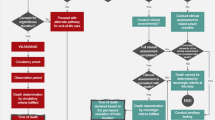Abstract
Introduction: Neurointensivists are at the front line of treatment of patients who progress to death by neurological criteria (DNC). Although some of these patients will become organ donors, there has not been a systematic evaluation of the opinions and resources available to neurointensivists in regard to these important issues.
Methods: We conducted a survey of neurointensivists regarding controversial issues in the declaration of DNC, procedures for discussing death and approaching donor families, and participation in donation after cardiac death (DCD).
Results: The majority of centers described by the respondents had all five most commonly accepted ancillary tests to determine DNC (61%). Radionuclide blood flow studies are the most frequently reported test used (64%). Younger physicians are more likely to use transcranial Doppler exams (TCD) than their older counterparts (41% versus 28%, p<0.001). Discussions about DNC with the family are most often presided by the attending physician, and donation requests are most commonly initiated by organ procurement organization (OPO) representatives, but there is significant variation from center to center. Nine out of 10 physicians in our survey reported that they are likely to participate in DCD.
Conclusion: Despite this enthusiasm, there is no clear consensus on many of the issues surrounding DCD, including how long after cardiac cessation recovery should begin. We believe that this study will serve as a springboard for more discussion about the diagnosis of DNC, the role of physicians in organ requests and donor management, and the procurement of organs through DCD.
Similar content being viewed by others
References
Diringer MN, Edwards DF. Admission to a neurologic/neurosurgical intensive care unit is associated with reduced mortality rate after intracerebral hemorrhage. Crit Care Med 2001;29:635–640.
Gortmaker SL, Beasley CL, Sheehy E, et al. Improving the request process to increase family consent for organ donation. J Transpl Coord 1998;8:210–217.
UNOS. http://www.unos.org/data/. Date accessed: August 3, 2005.
Williams MA, Lipsett PA, Rushton CH, et al. The physician’s role in discussing organ donation with families. Crit Care Med 2003;31:1568–1573.
Wamser P, Goetzinger P, Gnant M, Sautner T, Steininger R, Muhlbacher F. What do intensive care unit personnel think about organ donation? Opinion poll amongst transplant centers. Transplant Proc 1993;25:3122–3123.
Coleman-Musser L. The physician’s perspective: a survey of attitudes toward organ donor management. J Transpl Coord 1997;7:55–58.
Practice parameters for determining brain death in adults (summary statement). The Quality Standards Subcommittee of the American Academy of Neurology. Neurology 1995;45:1012–1014.
Medicare and Medicaid programs; hospital conditions of participation; identification of potential organ, tissue, and eye donors and transplant hospitals’ provision of transplant-related data—HCFA. Final rule. Fed Regist 1998;63:33856–33875.
Pearson IY, Zurynski Y. A survey of personal and professional attitudes of intensivists to organ donation and transplantation. Anaesth Intensive Care 1995;23:68–74.
Chernenko SM, Jensen L, Newburn-Cook C, Bigam DL. Organ donation and transplantation: a survey of critical care health professionals in nontransplant hospitals. Prog Transplant 2005;15:69–77.
Rachmani R. Physicians’ and nurses’ attitudes and knowledge toward brain death. Transplant Proc 1999;31:1912–1913.
Herdman R, Beauchamp TL, Potts JT. The Institute of Medicine’s report on non-heart-beating organ transplantation. Kennedy Inst Ethics J 1998;8:83–90.
Samson K. The gray zone: consensus on non-heart beating donor criteria remains elusive. Neurology Today 2002;2:7–8.
Arnold RM, Youngner SJ. The dead donor rule: should we stretch it, bend it, or abandon it? Kennedy Inst Ethics J 1993;3:263–278.
Zamperetti N, Bellomo R, Ronco C. Defining death in non-heart beating organ donors. J Med Ethics 2003;29:182–185.
DeVita MA, Snyder JV, Arnold RM, Siminoff LA. Observations of withdrawal of life-sustaining treatment from patients who became non-heart-beating organ donors. Crit Care Med 2000;28:1709–1712.
Bell MD. Non-heart beating organ donation: old procurement strategy—new ethical problems. J Med Ethics 2003;29:176–181.
Youngner SJ, Arnold RM. Ethical, psychosocial, and public policy implications of procuring organs from non-heart-beating cadaver donors. JAMA 1993;269:2769–2774.
Whetstine L, Bowman K, Hawryluck L. Pro/con ethics debate: is nonheart-beating organ donation ethically acceptable? Crit Care 2002;6:192–195.
Bos MA. Ethical and legal issues in non-heart-beating organ donation. Transplantation 2005;79:1143–1147.
Recommendations for nonheartbeating organ donation. A position paper by the Ethics Committee, American College of Critical Care Medicine, Society of Critical Care Medicine. Crit Care Med 2001;29:1826–1831.
Truog RD, Robinson WM. Role of brain death and the deaddonor rule in the ethics of organ transplantation. Crit Care Med 2003;31:2391–2396.
Young PJ, Matta BF. Anaesthesia for organ donation in the brainstem dead—why bother? Anaesthesia 2000;55:105–106.
Wace J, Kai M. Anaesthesia for organ donation in the brainstem dead. Anaesthesia 2000;55:590.
Author information
Authors and Affiliations
Corresponding author
Rights and permissions
About this article
Cite this article
Boissy, A.R., Javier Provencio, J., Smith, C.A. et al. Neurointensivists’ opinions about death by neurological criteria and organ donation. Neurocrit Care 3, 115–121 (2005). https://doi.org/10.1385/NCC:3:2:115
Issue Date:
DOI: https://doi.org/10.1385/NCC:3:2:115




